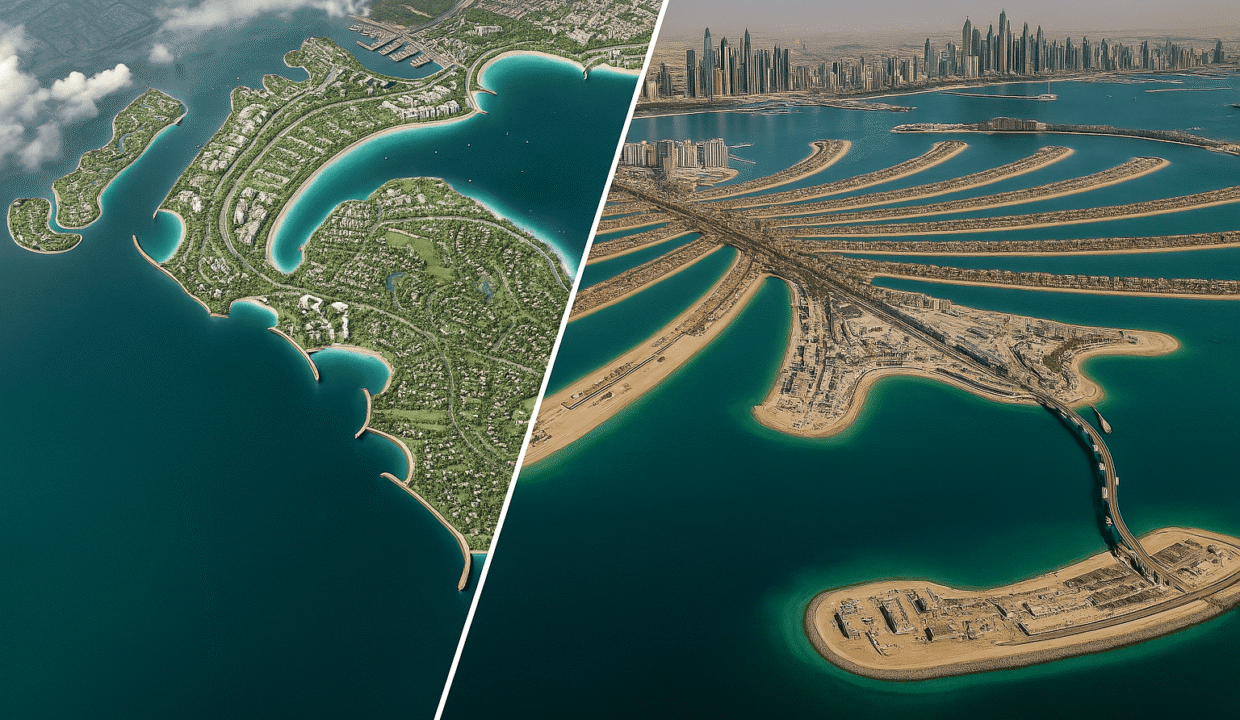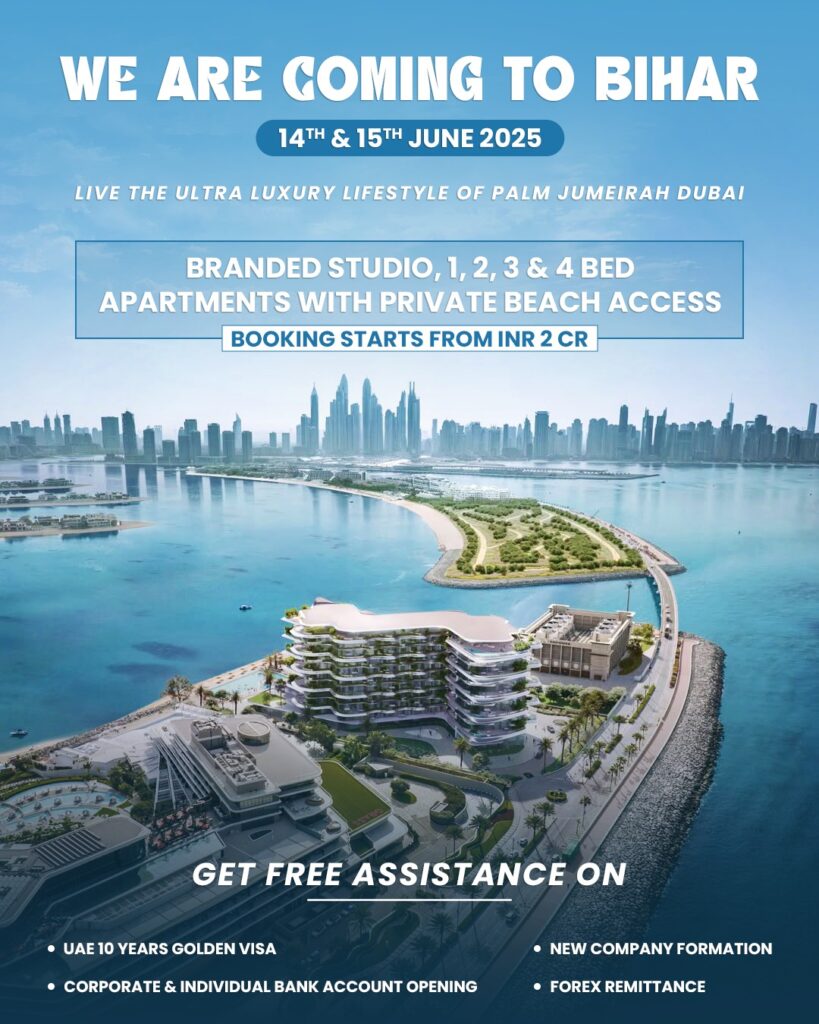Dubai Islands vs Palm Jumeirah: Where Should You Invest Today?
If you’ve ever dreamt about investing in Dubai real estate, chances are two destinations have popped up in your search: Palm Jumeirah and Dubai Islands. One is a headline-making luxury landmark. The other is a visionary megaproject just beginning to shape its identity. But the question isn’t just which is more famous—it’s which one fits your goals, your budget, and your appetite for risk and reward.
Let’s break it all down without the fluff, so you can decide where your money is best invested.
The Legacy and the Newcomer
Palm Jumeirah was never just a development; it was Dubai’s bold statement to the world. A palm-shaped island stretching into the Arabian Gulf, it redefined what waterfront luxury could look like. Since it welcomed its first residents in the early 2000s, Palm has become a magnet for celebrities, business moguls, and global investors. It’s a fully developed, fully operational ecosystem with no learning curve for newcomers. Everything you expect from high-end living—private beaches, five-star hotels, beach clubs, gourmet dining—is not only available but woven into everyday life.
Projects like Six Senses Residences, The Palm Beach Tower, and Frond Villas continue to attract investors seeking either long-term capital preservation or immediate luxury living. Palm isn’t just about owning property—it’s about being part of a brand that carries global prestige.
Dubai Islands, on the other hand, is still writing its story. Rebranded from Deira Islands, this ambitious development is part of Dubai’s long-term vision to expand urban living, tourism, and green spaces in the northern part of the city. Its master plan includes five interconnected islands designed for smart living, cultural enrichment, and environmental sustainability. It’s not finished yet, and that’s exactly why some investors are paying close attention.
Standout upcoming communities include Bay Villas by Nakheel, Rixos Residences, and Deira Waterfront, offering a mix of family homes, branded residences, and mid-market investment units.
What Makes Palm Jumeirah a Safe Bet?
Let’s talk numbers. Some high-end two-bedroom apartments at The Palm Tower have sold for around AED 3.2 million and are being rented at approximately AED 230,000 annually. That works out to a gross rental yield of just over 7% in certain cases, which is considered strong for a mature and stable market like Palm Jumeirah. Of course, yield can vary based on unit type, furnishing, view, and whether it’s leased long-term or as a serviced apartment.
But it’s not just about yield. Palm Jumeirah also offers peace of mind. Property values have shown consistent performance, especially for well-maintained units and properties in prime locations on the trunk or crescent. The resale market is active, and the area enjoys strong liquidity because of its brand recognition.
The catch? You’ll need deeper pockets to enter the game. High-end apartments, villas, and branded residences here come at a premium. And while the area’s value tends to hold, don’t expect sudden surges in capital appreciation like you might find in emerging neighborhoods.
Why Dubai Islands is Gaining Investor Attention
While Palm Jumeirah plays the part of the established blue-chip asset, Dubai Islands resembles a promising growth stock—undervalued by some, loaded with upside for those who get in early.
Pricing is currently far more accessible. Several developers are offering off-plan units at entry points that would be unthinkable in the Palm. With flexible payment plans, longer handover timelines, and government-backing through Nakheel, Dubai Islands is being positioned as a future city—integrated, walkable, and connected to the cultural heart of Old Dubai.
One of the lesser-discussed advantages of this location is accessibility. While Palm Jumeirah is more associated with the new Dubai skyline and leisure districts, Dubai Islands brings you closer to Deira, the airport, and the Sharjah border. For buyers interested in renting to long-term tenants—particularly professionals and families—this could be a practical and profitable advantage.
Over at Dubai Islands, early investors who bought in 2023 have reportedly seen property values rise by 10% to 12% before handover. While rental yields are still speculative at this stage, some market projections estimate potential returns of 6% to 9% in the coming years as infrastructure matures and rental demand picks up. These figures make Dubai Islands appealing to buyers seeking long-term upside and early-mover advantages.
Lifestyle and Infrastructure: Present Comfort vs. Future Promise
Living in Palm Jumeirah means stepping into a world that’s already functioning at full speed. Fancy a sushi dinner by a Michelin-starred chef? Need to drop the kids at a premium school or yoga studio by the beach? Want to rent out your apartment to high-paying short-term tenants? Everything is ready and waiting.
Residents enjoy amenities like Nakheel Mall, Atlantis Aquaventure, private beach clubs, and quick access to Dubai Marina and Jumeirah Road. The island even has its own monorail, linking it to the mainland with ease.
Dubai Islands is currently more of a construction zone than a community, but its plans are no less ambitious. Developers have committed to creating a new standard of living centered on sustainability, green space, and a mix of cultural, commercial, and residential facilities. Think public waterfront parks, eco-conscious buildings, and wellness retreats.
Key highlights include a Blue Flag-certified beach, a planned Dubai Islands Marina, and community zones featuring walkable boardwalks and green corridors. It’s not about what’s there today—it’s about the blueprint for tomorrow.
So, are you someone who values immediate lifestyle perks, or are you happy to wait a few years for a carefully master-planned hub to come alive?
Risk Tolerance: Where Do You Stand?
Every investor must ask themselves a simple but essential question: What kind of risk am I comfortable with?
With Palm Jumeirah, the risks are few—but the cost of entry is high. You’re investing in an area that has passed the test of time, economic downturns, and market cycles. The trade-off is that you won’t see explosive growth, but you’ll get predictability and prestige.
With Dubai Islands, the reward potential is higher—but so are the variables. Construction delays, evolving market sentiment, and unproven rental demand could all affect your returns. However, the combination of early-buyer pricing, developer incentives, and future infrastructure plans makes it a compelling opportunity for those willing to wait.
This isn’t about choosing a winner and loser—it’s about aligning your choice with your investment style.
What Is the Market Saying?
While Dubai’s real estate sector continues to attract global attention, recent industry reports predict a correction in mid-tier areas due to a surge in new housing supply. That said, prime zones and government-endorsed developments remain shielded by strong fundamentals.
Palm Jumeirah benefits from international demand and brand equity, while Dubai Islands benefits from strategic planning and long-term government support through Vision 2040. Investors in either zone are aligning with a broader economic roadmap rather than taking blind risks.
One noteworthy factor is how both areas are backed by Nakheel—a developer known for delivering some of Dubai’s most iconic projects. That alone adds credibility to Dubai Islands and sustains investor trust in Palm.
A Quick Comparison Summary
- Palm Jumeirah: Premium pricing, immediate returns, high liquidity, established lifestyle, low risk
- Dubai Islands: Affordable entry, future growth, long-term appreciation, sustainability-driven, moderate risk
So, What’s the Right Move for You?
If you value liquidity, prestige, and minimal uncertainty, Palm Jumeirah is a smart place to park your capital. It’s ready, resilient, and rental-ready. Whether you’re looking to generate income or diversify a high-value portfolio, it ticks the boxes.
If you’re eyeing long-term growth, want to enter Dubai’s real estate market at a lower price point, and don’t mind waiting a few years, Dubai Islands could offer higher returns—both in rental yield and capital appreciation. It’s a rare chance to buy into a new waterfront community before the masses do.
Ultimately, your choice depends on your horizon, your budget, and your risk tolerance. Both options are valid. Both are backed by vision. And both are shaping the next chapter of one of the world’s fastest-growing cities.
Need help deciding which opportunity is right for you?
Contact the team at SAMS for personalised guidance and exclusive listings in both Palm Jumeirah and Dubai Islands. We’re here to help you make the smartest move in Dubai real estate.


